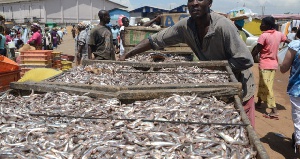For the first time in three years, the countries fishing sector has shown signs of a promising future as figures from the Ghana Statistical Service indicate it has finally recorded growth after a period of contraction.
The fishing sector has been in abysmal form since 2017, when growth contracted to 1.4 percent and further declined to -6.8 percent in 2018. However, at the end of 2019 the sector was able to record 1.7 percent growth, making it the first time since 2016 that it grew – by 3.1 percent.
The 2019 rebound indicates that when proper measures are put in place to address the fishing sector’s challenges, it will be possible to recapture the glory years when it was contributing significantly to the economy.
Currently, fishing’s contribution to total GDP is one of the smallest among all sectors in the country, only second to water and sewage. The industry contributed a pittance of 0.9 percent to GDP in 2019, whereas water and sewage were 0.4 percent.
Professor Emeritus Kobina Yankson, Department of Fisheries and Aquatic Sciences at the University of Cape Coast, says if government puts appropriate measures in place to successfully stamp out Illegal, Unreported and Unregulated fishing – especially, saiko, the industry can regain its fame and create jobs for the youth.
“Our fisheries sector, especially the marine section, is facing challenges; and those challenges have to be removed if the gains in contribution to GDP are to be made. The Illegal, Unreported and Unregulated fishing must be stopped, especially, saiko fishing. So, for us to improve growth in the sector, appropriate fishing management must be in place to address the challenges,” he told the B&FT in an interview.
According to a report dubbed ‘Stolen at Sea: How illegal saiko fishing is fuelling the collapse of Ghana’s fisheries’, approximately 100,000 tonnes of fish were landed illegally in 2017, representing 60 percent of total catches. The value of these fish is estimated to be between US$40.6 and US$50.7million when sold at sea, and between US$52.7 and US$81.1million when sold at the saiko landing sites of Elmina, Apam and Axim.
Prof. Yankson further called for investment to be made in the aquaculture industry to supplement the marine sector, which is reeling under the pressure of saiko activities.
“We also need to invest in aquaculture to supplement it. In Ghana we are only doing catfish and tilapia. But we can diversify and improve it. We have wild oysters in the coastal areas and all these are opportunities for aquaculture,” he said.
His opinion is supported by Kyei Kwadwo Yamoah, Programmes Manager for Friends of the Nation – a European Union fisheries initiative, who attributes the 2019 rebound in growth to gains made by aquaculture. For him, there is need for a deliberate government policy coupled with public-private partnership to sustain and improve the fishing sector’s fortunes.
“We have seen substantial growth in aquaculture, and the Fishing for Food and Jobs also brought some investments in the area. So, I would say these contributed to the growth in 2019. But it is important to note that a lot of challenges in the fishing sector have not really changed. There is no drastic fishing management and plan in place to address challenges in the marine sector.
“There is a huge untapped potential for aquaculture, and there is market for it too. So, we have even recommended that we should step up community fishing projects, so that it can create jobs for the youth. A very rigorous investment from government and the private sector can boost fishing growth,” he told B&FT.
Business News of Thursday, 4 June 2020
Source: thebftonline.com

















